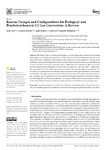Mostrar el registro sencillo del ítem
Reactor Designs and Configurations for Biological and Bioelectrochemical C1 Gas Conversion: A Review
| dc.contributor.author | Ayol, Azize | |
| dc.contributor.author | Peixoto, L. | |
| dc.contributor.author | Keskin Gundogdu, Tugba | |
| dc.contributor.author | Nalakath Abubackar, Haris | |
| dc.date.accessioned | 2021-11-26T11:39:41Z | |
| dc.date.available | 2021-11-26T11:39:41Z | |
| dc.date.issued | 2021-11-07 | |
| dc.identifier.citation | Ayol, A.; Peixoto, L.; Keskin, T.; Abubackar, H.N. Reactor Designs and Configurations for Biological and Bioelectrochemical C1 Gas Conversion: A Review. Int. J. Environ. Res. Public Health 2021, 18, 11683. https://doi.org/10.3390/ijerph182111683 | es_ES |
| dc.identifier.issn | 1660-4601 | |
| dc.identifier.uri | http://hdl.handle.net/2183/28963 | |
| dc.description.abstract | [Abstract] Microbial C1 gas conversion technologies have developed into a potentially promising technology for converting waste gases (CO2, CO) into chemicals, fuels, and other materials. However, the mass transfer constraint of these poorly soluble substrates to microorganisms is an important challenge to maximize the efficiencies of the processes. These technologies have attracted significant scientific interest in recent years, and many reactor designs have been explored. Syngas fermentation and hydrogenotrophic methanation use molecular hydrogen as an electron donor. Furthermore, the sequestration of CO2 and the generation of valuable chemicals through the application of a biocathode in bioelectrochemical cells have been evaluated for their great potential to contribute to sustainability. Through a process termed microbial chain elongation, the product portfolio from C1 gas conversion may be expanded further by carefully driving microorganisms to perform acetogenesis, solventogenesis, and reverse β-oxidation. The purpose of this review is to provide an overview of the various kinds of bioreactors that are employed in these microbial C1 conversion processes. | es_ES |
| dc.description.sponsorship | Turquía. Dokuz Eylul University; 2011.KB.FEN.046 | es_ES |
| dc.description.sponsorship | Turquía. Scientific and Technological Research Council of Turkey; 119R029 | es_ES |
| dc.description.sponsorship | Portugal. Fundação para a Ciência e a Tecnologia; UIDB/04469/2020 | es_ES |
| dc.description.sponsorship | Portugal. Fundação para a Ciência e a Tecnologia; POCI-01-0145-FEDER-031377 | es_ES |
| dc.description.sponsorship | Turquía. Scientific and Technological Research Council of Turkey; 118Y305 | es_ES |
| dc.description.sponsorship | Xunta de Galicia; ED431C 2021/55 | es_ES |
| dc.description.sponsorship | Xunta de Galicia; ED481D 2019/033 | es_ES |
| dc.language.iso | eng | es_ES |
| dc.publisher | MDPI | es_ES |
| dc.relation.uri | https://doi.org/10.3390/ijerph182111683 | es_ES |
| dc.rights | Atribución 4.0 Internacional | es_ES |
| dc.rights.uri | http://creativecommons.org/licenses/by/4.0/ | * |
| dc.subject | Syngas fermentation | es_ES |
| dc.subject | Microbial chain elongation | es_ES |
| dc.subject | Hydrogenotrophic methanation | es_ES |
| dc.subject | Bioreactors | es_ES |
| dc.subject | Electromethanogenesis | es_ES |
| dc.subject | Microbial electrosynthesis | es_ES |
| dc.subject | Biofilm | es_ES |
| dc.subject | Gas–liquid mass transfer | es_ES |
| dc.subject | Biocathode | es_ES |
| dc.title | Reactor Designs and Configurations for Biological and Bioelectrochemical C1 Gas Conversion: A Review | es_ES |
| dc.type | journal article | es_ES |
| dc.rights.accessRights | open access | es_ES |
| UDC.journalTitle | International Journal of Environmental Research and Public Health | es_ES |
| UDC.volume | 18 | es_ES |
| UDC.issue | 21 | es_ES |
| UDC.startPage | 11683 | es_ES |
| dc.identifier.doi | 10.3390/ijerph182111683 | |
| UDC.coleccion | Investigación | es_ES |
| UDC.departamento | Química | es_ES |
| UDC.grupoInv | Bioenxeñaría Ambiental e Control de Calidade (BIOENGIN) | es_ES |
Ficheros en el ítem
Este ítem aparece en la(s) siguiente(s) colección(ones)
-
Investigación (FCIE) [1243]






